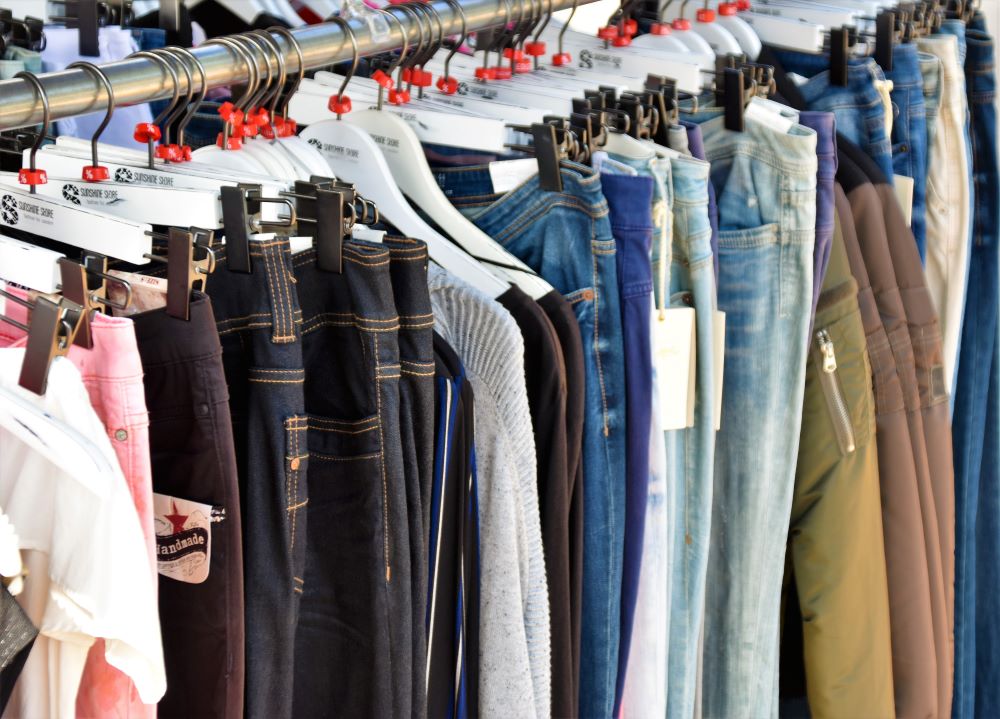
(Unsplash/Waldemar Brandt)
Our clothing donations may be doing more harm than good, and as Christians, it is time we rethink what it means to "give to the poor."
Christians are encouraged by the biblical text, the words of the saints and the homilies we hear each Sunday to “give to the poor.” St. Basil of Caesarea, for instance, frames giving as an act of justice. In his homily "I Will Tear Down My Barns," Basil accosts those who, by hoarding possessions, do injustice to their neighbors:
Is not the person who strips another of clothing a thief? And those who do not clothe the naked when they have the power to do so, should they not be called the same? […] The clothes you keep put away are for the naked, the shoes that are rotting away with disuse are for those who have none … You are thus guilty of injustice toward as many as you might have aided, and did not.
Basil's indictment, though uncomfortable, is familiar to the Christian ear. His words gesture toward the seven corporal works of mercy, specifically, to clothe the naked. The impulse to scrutinize and give of our belongings is, in many ways, integral to the Christian worldview. Christ's call to "go and sell your possessions and give to the poor" reverberates beyond the pulpit into the households of the faithful (Mt 19:21). Organizations such as Goodwill and Salvation Army, both of which were founded by Christians, serve as outlets for anxious Christians to give for "good." Beyond distinctly Christian voices, figures such as Marie Kondo encourage consumers to habitually donate items that no longer "spark joy." Wielding both secular and religious endorsements, we march our clothes to donation sites, assured that our garments will aid the needy.
Yet the afterlife of our donations reveals otherwise.
Advertisement
Of the clothing that is donated to secondhand stores in the United States, about 20% is sold to consumers — and the rest is discarded or sent abroad. Fashionista reported that in 2014, 11% of Goodwill donations — equivalent to 22 million pounds — were seen as "unfit for sale," and were discarded in landfills. The volume of donations distributed in global markets is staggering. For example, the United States alone distributes $720 million worth of used clothing throughout the world. Some argue that these exports yield fruitful results for importing countries, such as opportunities for job growth in the secondary clothing market.
Elizabeth Ricketts, founder of The OR Foundation, challenges this claim. She cites the Kantamanto Market, one of the world's largest resale economies in Accra, Ghana, as an example. Ricketts notes that the 30,000 workers of Kantamanto face unjust risk: "Retailers take out loans with 35 percent interest rates to purchase the bales of clothing that have been shipped from all over the world […] With only 20 percent of Kantamanto's retailers making a profit, many refer to their business as a 'gambling job.' "
Furthermore, local businesses can't compete with mounting imports of cheap, used clothing. Secondhand garments run as cheap as 5% of the cost of a new garment made by local artisans. And so these donations — our donations — further undermine the local economies that receive them, contributing to the collapse of garment industries worldwide.
Beyond undermining local economies, our clothing donations have environmental costs for these global communities. For example, although Kantamanto resells 100 million items every quarter, 40% of clothing received by the market becomes waste. This waste, Ricketts explains, "is burned in the open air, swept into the gutter…[and is] dumped in informal settlements where…vulnerable citizens live." These communities, in short, buckle under the weight of our wares.
Kantamanto reveals the troubling afterlife of our clothing donations. Ricketts acknowledges that those who donate "have truly kind, however naïve, intentions," but are misled to think "that their clothes will find a second life with someone who needs the thing that they no longer want." Similarly, Christian donors trust that their actions "clothe" their needy neighbors in compassionate care, dignity and justice. Sadly, it’s more likely that we clothe the vulnerable in violence, by exporting our excesses to more vulnerable economies, saddling them with the fruits of consumer frenzy, and polluting the lands on which they live, work and sleep.
While acknowledging these harrowing truths, it is also important to note that the impacts of donation vary widely. Some donations do reach the hands of those who are in desperate need. Furthermore, the EPA reports that 85% of unused textiles are discarded in U.S. landfills yearly. Donating clothes, then, is far better than discarding them. Still, Christian consumers must interrogate how we think of our clothes, and of donations. Does the Christian exhortation to "give" of our belongings, broadly understood, sanctify mindless spending? Does it allow us to indulge, reassuring us that we can always pass on our seconds to "the needy"?
Of course, consumers are not solely to blame.
Excess clothing donations are symptoms of a larger problem: rampant overconsumption, fueled by corporations and the global garment industry, which creates between 80 billion and 150 billion garments per year. A culture of overconsumption is, after all, made possible by structures of overproduction. In a culture known for self-storage units and glamorized retail therapy, it becomes all too easy to disguise our individual and collective vice as charity. We can no longer ignore the human and environmental sins born of our consumptive practices, which net a staggering 16 million tons of textile waste per year.
We can consume less, so that we avoid viewing donating as a way to unclutter our lives.
What can the conscious Catholic do, besides despair? For one, confronting this scene allows us the opportunity to cultivate virtue. In the face of endless sales and stock, we can choose items that will last, or content ourselves with what we have. We can consume less, so that we avoid viewing donating as a way to unclutter our lives. And we can orient ourselves away from the companies and social mores that endorse "harmless" retail therapy. To do so is a small grace to the communities that buckle under our cheap thrills.
"Clothing" ourselves in prudence, temperance and other virtues can help us encounter anew the seminal texts and thinkers that have informed our steps as believers and enrich our understanding of timeless adages as they fit our present milieu. We might, for instance, revisit Basil through a religious lens informed by the economic, environmental and sociopolitical realities of contemporary clothing production, consumption and donation. Here, Basil's question "Are you not a robber?” becomes a pointed indictment of how garment production processes rob communities of natural resources. We might recognize how Basil's thief, who "strips another of clothing," is akin to corporations stripping communities and lands of their earthen "clothing." We can further think of those dispossessed by our consumptive systems: transnational garment workers, local economies across the world and more.
Finally, "clothing" ourselves anew in revived words and virtue can guide us in "clothing" others well. How can we clothe others in justice? For Ricketts, justice materializes in policy and practice. She endorses efforts to reduce production quantities in the garment industry, to correct environmental damage done to communities that receive secondhand waste and to adjust wages for those who make the clothes that we shop, wear and donate. We might also pursue practices of solidarity, like donating to the Secondhand Solidarity Fund, which directly supports the Kantamanto community.
Justice will look different for each community. We should think creatively about how to, in Basil's own words, "distribute [our] wealth lavishly" to those made vulnerable and marginalized. Here, we can think of our wealth beyond our bursting wardrobes and consider how we can share our wealth of time, energy, privilege, access and platform. To do so is to get to the heart of the Gospel, and to clothe ourselves and our neighbors well.








